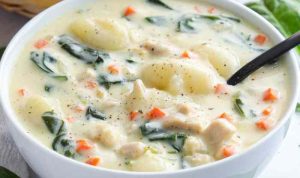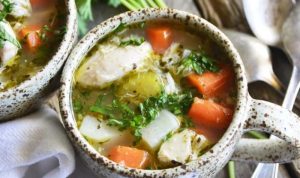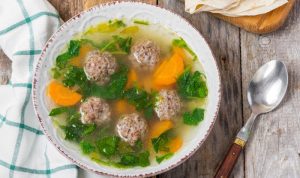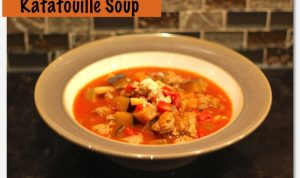Hearty Winter Soups: A Culinary Embrace
Good soup recipes for winter – Winter’s chill often calls for comforting and nourishing meals, and few dishes fulfill this need quite like a steaming bowl of hearty soup. The appeal of soup during the colder months extends beyond simple sustenance; it offers warmth, flavor, and a sense of homeliness that perfectly complements the season.
Reasons for Winter Soup Popularity
Three key reasons contribute to soup’s wintertime popularity: its inherent warmth, its versatility in incorporating seasonal ingredients, and its nutritional benefits. The warmth of a hot soup is immediately comforting on a cold day, providing both physical and emotional solace. The ability to use seasonal vegetables like root vegetables, winter squash, and hearty greens allows for endless variations in flavor and texture.
Finally, soups are often packed with nutrients, offering a healthy and satisfying meal.
Nutritional Benefits of Winter Soups
Winter soups provide a wealth of nutritional benefits. They are often rich in vitamins and minerals from the vegetables used, and the broth itself can be a good source of electrolytes. The combination of vegetables, protein (from beans, lentils, or meat), and carbohydrates provides a balanced meal that helps sustain energy levels during the colder months. Soups are also a great way to increase your intake of fiber, crucial for digestive health.
Classic Winter Soup Recipes
Several classic soup recipes perfectly embody the comforting nature of winter cuisine. Three examples, French Onion, Chicken Noodle, and Tomato Soup, showcase the diversity and appeal of these timeless dishes.
| Soup Name | Main Ingredients | Cooking Time | Serving Suggestions |
|---|---|---|---|
| French Onion Soup | Onions, beef broth, thyme, baguette, Gruyère cheese | 45-60 minutes | Serve hot in oven-safe bowls with toasted baguette and melted cheese. |
| Chicken Noodle Soup | Chicken broth, chicken, noodles, carrots, celery, onion | 30-45 minutes | Serve hot with a side of crusty bread or crackers. |
| Tomato Soup | Tomatoes, vegetable broth, onion, garlic, basil | 30-40 minutes | Serve hot with a grilled cheese sandwich or a dollop of crème fraîche. |
Unique and Adventurous Winter Soup Recipes
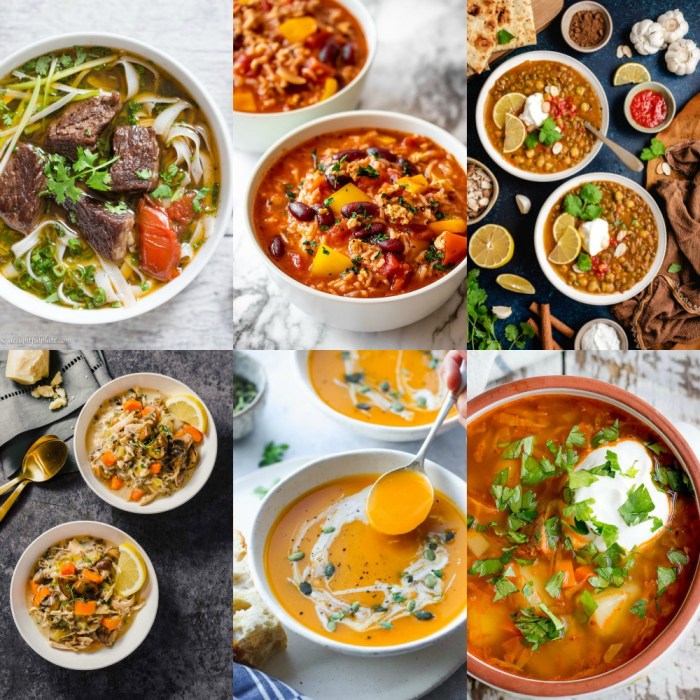
Source: thetoastykitchen.com
Beyond the classics, winter offers an opportunity to explore unique and adventurous soup recipes featuring seasonal and unusual ingredients. These recipes often showcase unexpected flavor combinations and textures, adding a new dimension to the winter culinary experience.
Examples of Unique Winter Soups
- Butternut Squash and Apple Soup with Sage: This soup combines the sweetness of butternut squash and apple with the earthy aroma of sage. It offers a creamy texture and a balanced sweet and savory flavor profile. Adaptations for different diets are easily made: omit the butter for a vegan version; use gluten-free broth for gluten-free needs.
- Spicy Carrot and Ginger Soup with Coconut Milk: This vibrant soup blends the sweetness of carrots with the warmth of ginger and the richness of coconut milk. The spice level can be adjusted to suit individual preferences. This recipe is naturally vegan and gluten-free.
- Roasted Red Pepper and Chorizo Soup: This hearty soup combines the sweetness of roasted red peppers with the smoky flavor of chorizo. For a vegetarian version, substitute the chorizo with roasted vegetables like eggplant or mushrooms. To make it gluten-free, ensure the broth is gluten-free.
Soup Preparation Techniques and Tips
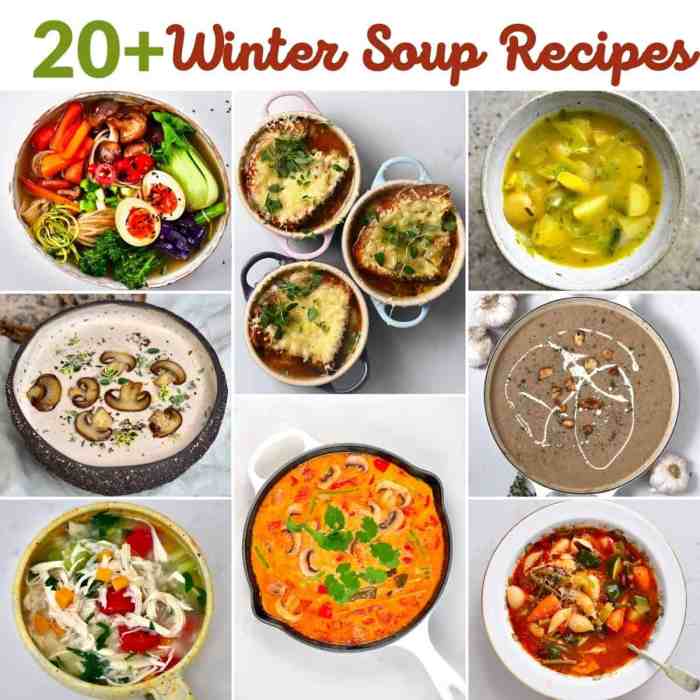
Source: alphafoodie.com
Mastering a few key techniques significantly enhances the quality of your winter soups. Proper broth preparation and skillful use of herbs and spices are crucial for creating truly exceptional dishes.
Vegetable Broth Preparation, Good soup recipes for winter
Begin with high-quality ingredients. Use fresh, seasonal vegetables for a richer flavor. Roast the vegetables before simmering them for a deeper, more complex taste. Simmer gently for at least an hour to allow the flavors to meld. Strain the broth through a fine-mesh sieve to remove any solids.
Flavor Enhancement with Herbs and Spices
Herbs and spices play a crucial role in enhancing the flavor of soups. Experiment with combinations to create unique flavor profiles. Add herbs towards the end of cooking to preserve their delicate flavors. Use spices judiciously, starting with small amounts and adjusting to taste.
Common Mistakes to Avoid
- Overcrowding the pot: This can lead to uneven cooking and a watery broth.
- Adding too much liquid at once: This can dilute the flavor.
- Not seasoning properly: Taste and adjust seasoning throughout the cooking process.
- Ignoring the importance of simmering: Simmering allows flavors to develop fully.
Serving and Presentation of Winter Soups: Good Soup Recipes For Winter
The presentation of a soup significantly impacts the overall dining experience. Careful attention to garnishes, serving style, and ambiance elevates a simple bowl of soup into a memorable culinary moment.
Garnishes and Toppings
- Fresh herbs (parsley, chives, thyme)
- Croutons or toasted bread
- A swirl of cream or crème fraîche
- Shredded cheese
- Roasted vegetables
Serving Styles
For casual settings, serve soup in rustic bowls. For formal occasions, use elegant bowls and consider adding a small garnish. The warmth of the soup, visible as steam rises from the bowl, creates a comforting and inviting atmosphere. The sight of condensation forming on the sides of the bowl, combined with the aromatic steam rising gently upwards, evokes a sense of warmth and coziness, enhancing the sensory experience of enjoying the soup.
Winter Soup Variations and Adaptations
The versatility of soups allows for countless variations and adaptations. Understanding the characteristics of different soup bases and techniques for adjusting heartiness, spice levels, and flavor profiles unlocks a world of culinary possibilities.
Soup Bases
Broth-based soups offer a light and flavorful base; cream-based soups provide richness and creaminess; bisques, typically made with shellfish or vegetables, feature a smooth and velvety texture. Each base lends itself to different ingredients and flavor profiles.
Making Soups Heartier
- Add grains like barley or quinoa.
- Incorporate lentils or beans.
- Include pasta or dumplings.
Adjusting Spice Levels and Flavors
Adjust the spice level by adding chili flakes, cayenne pepper, or other spices to taste. Experiment with different herbs and spices to create unique flavor profiles. Consider adding a touch of acidity (lemon juice or vinegar) to balance sweetness or richness.
Storage and Reheating of Winter Soups
Proper storage and reheating techniques are essential for preserving the quality and flavor of leftover soups.
Storage
Allow soup to cool completely before storing in airtight containers in the refrigerator. Soups generally last for 3-4 days in the refrigerator. Label containers with the date to ensure freshness.
Winter calls for warming, comforting soups, and there’s a delightful variety to explore. For a lighter yet satisfying option, consider incorporating a detoxifying element into your repertoire. A fantastic recipe to try is this detox cabbage soup recipe , perfect for cleansing and boosting your well-being during the colder months. Ultimately, the best winter soup is the one that best suits your palate and dietary needs.
Reheating
Reheat soup gently on the stovetop, stirring occasionally to prevent scorching. Avoid boiling, as this can alter the texture and flavor. Microwave reheating is also an option, but be mindful of uneven heating.
Freezing Soup
Allow soup to cool completely before freezing in airtight containers. Leave some headspace in the container to allow for expansion. Frozen soup generally lasts for 2-3 months.
Questions Often Asked
Can I make soup ahead of time?
Absolutely! Many soups taste even better the next day. Store properly in airtight containers in the refrigerator for up to 3-4 days.
How can I thicken my soup?
You can thicken soup by adding a roux (butter and flour), pureed vegetables, or a cornstarch slurry.
What are some good freezer-friendly soups?
Hearty vegetable soups, chicken noodle soup, and lentil soups freeze well. Avoid soups with a high cream content.
How do I prevent my soup from becoming watery?
Simmer uncovered for a longer period to allow excess liquid to evaporate. You can also remove some of the broth before serving.


